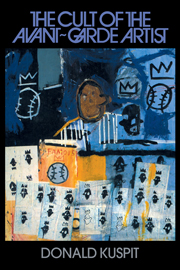Book contents
- Frontmatter
- Contents
- 1 Avant-Garde and Neo-Avant-Garde: From the Pursuit of the Primordial to the Nihilism of Narcissism
- 2 Preliminary Therapeutic Attitude: The Provocative Object as a Path to Primordiality – Picasso and Duchamp
- 3 The Geometrical Cure: Art as a Matter of Principle – Mondrian and Malevich
- 4 The Expressive Cure: Art as the Recovery of Primal Emotion – Expressionism and Surrealism
- 5 Fame as the Cure-All: The Charisma of Cynicism – Andy Warhol
- 6 Enchanting the Disenchanted: The Artist's Last Stand – Joseph Beuys
- 7 The Decadence or Cloning and Coding of the Avant-Garde: Appropriation Art
- Notes
- Index
4 - The Expressive Cure: Art as the Recovery of Primal Emotion – Expressionism and Surrealism
Published online by Cambridge University Press: 05 June 2012
- Frontmatter
- Contents
- 1 Avant-Garde and Neo-Avant-Garde: From the Pursuit of the Primordial to the Nihilism of Narcissism
- 2 Preliminary Therapeutic Attitude: The Provocative Object as a Path to Primordiality – Picasso and Duchamp
- 3 The Geometrical Cure: Art as a Matter of Principle – Mondrian and Malevich
- 4 The Expressive Cure: Art as the Recovery of Primal Emotion – Expressionism and Surrealism
- 5 Fame as the Cure-All: The Charisma of Cynicism – Andy Warhol
- 6 Enchanting the Disenchanted: The Artist's Last Stand – Joseph Beuys
- 7 The Decadence or Cloning and Coding of the Avant-Garde: Appropriation Art
- Notes
- Index
Summary
That which belongs to the spirit of the future can only be realized in feeling, and to this feeling the talent of the artist is the only road.
Wassily KandinskyLiberating the elements, subdividing them, simultaneously and on all sides tearing them down and building them up, a pictorial polyphony, peace achieved by harmonizing motions: all these are very important formal issues, crucial to wisdom about form, but not art in the highest sense. In the highest sense an ultimate mystery lies behind all this complexity and in its presence the light of intellect sputters and goes out.
Art plays an ignorant game with ultimate things and yet manages to reach them.
Paul KleeThe day is not far off when a picture will have the value, and only the value, of a simple moral act, and yet this will be the value of a simple unmotivated act.
Salvador DaliFrom the expressive point of view, the “ultimate thing,” the “ultimate mystery,” is emotion, but not ordinary emotion: “Emotions such as fear, joy, grief, etc.,” Wassily Kandinsky wrote, “will no longer greatly attract the artist. He will endeavor to awake subtler emotions, as yet unnamed. Living himself a complicated and comparatively subtle life, his work will give to those observers capable of feeling them lofty emotions beyond the reach of words.” Such emotions are “the internal truth which only art can divine, which only art can express by those means of expression which are hers alone,” Without this “internal truth of art,” this “soul” that is “the ‘what’” of art, “the body (i.e., the ‘how’) can never be healthy, whether in an individual or in a whole people.”
- Type
- Chapter
- Information
- The Cult of the Avant-Garde Artist , pp. 53 - 63Publisher: Cambridge University PressPrint publication year: 1993



